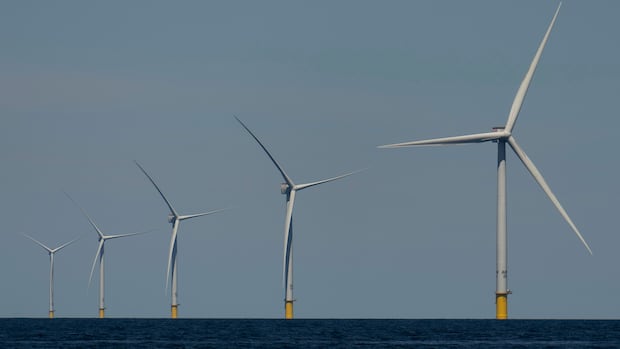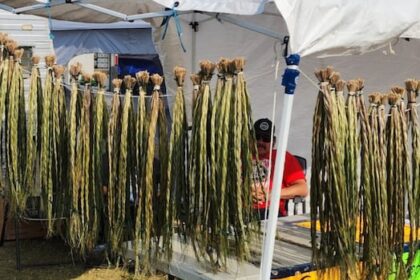Nova ScotiaNova Scotia’s PC government wants to become a major energy exporter, but the fishing industry that currently dominates the province’s export portfolio is worried it could be sidelined by that effort.Fishing groups are calling for the province to slow downTaryn Grant · CBC News · Posted: Oct 10, 2025 5:00 AM EDT | Last Updated: 4 hours agoA wind farm off the coast of Massachusetts is seen in this file photo. Nova Scotia is gunning to have its first offshore turbines operating by 2033. (The Associated Press)Nova Scotia’s PC government wants to become a major wind energy exporter, but the fishing industry that currently dominates the province’s export portfolio is worried it could be sidelined by that effort.“I’m really concerned,” said Nancy Wadden, a 30-year veteran of the industry who harvests lobster, snow crab and halibut off Cape Breton Island.“Our voices are being heard to a certain extent, but I don’t think they’re being heard enough,” said Wadden, president of the Maritime Fishermen’s Union Local 6.Wadden and other fish harvesters are worried that — among other things — they’ll be elbowed out of lucrative fishing grounds because of buffers around offshore wind turbines or changes to the ocean ecosystem.The province has engaged with the industry while developing its regulatory framework and choosing sites for potential development, but that hasn’t been enough to satisfy Wadden.She said she’s particularly worried about snow crab in an area called Sydney Bight, which is one of four potential offshore wind areas where developers could soon bid on licences.She said if subsea transmission cables from wind turbines warm the water even slightly, it could drive away the temperature-sensitive crustacean.Wadden said offshore wind development has become a regular part of conversations she has with the 115 members of her union.Slow down, fishers pleadShe said she wants the provincial government to slow down. A strategic plan released last month targets 2033 to have the first turbine blades spinning — a timeline that outpaces the typical buildup time seen in other countries.“I feel Premier [Tim] Houston is moving this ahead at a very rapid pace and I think there needs to be a lot more study and a lot more thought put into what is actually going to happen to the fishing industry,” Wadden said.Dan Fleck, executive director of the Brazil Rock 33/34 Lobster Association, is also calling for the province to tap the brakes, especially since Houston dramatically upped the scale of his ambition for offshore wind.Dan Fleck, executive director of the Brazil Rock 33/34 Lobster Association, pictured Oct. 9, 2025, in Halifax. (Taryn Grant/CBC)“Things have changed,” he said, referring to Houston’s new “Wind West” plan, which includes a $60-billion buildout of offshore wind farms and a transmission line for export.“We need to do this right. Why would we risk an industry that has fed us for hundreds of years for the sake of a technology that could be obsolete in 10 or 15 years?” said Fleck.Fleck recently travelled to Scotland to learn how offshore wind projects have affected fisheries in those waters.His big takeaway, he said, is that offshore wind has been “devastating” to Scottish fishers.“They can’t go near [the turbines] and they’ve lost access to their wharves and they’ve lost fishing jobs,” he said.No consensus on compensationNeither Fleck nor Wadden are completely opposed to having offshore wind turbines in Nova Scotian waters. They said they believe the fishing and offshore wind industries can coexist with the right scale and pace of development.They differ on the issue of compensation. Wadden said she thinks payouts for displaced fishers are part of the solution. Fleck does not.“Captains have said they don’t want compensation. They want to continue to fish,” he said.A small lobster boat in Riverport, N.S., on the LaHave River. (Robert Short/CBC)It is not clear where the province stands on compensation. CBC News asked the Department of Energy about compensation plans, along with several other questions, and the department’s emailed response ignored the topic.“The federal and provincial governments have been consulting and engaging for years to develop Nova Scotia’s offshore wind industry sustainably and responsibly,” the statement said, in part.“We are confident that both our offshore wind and our fisheries sectors will succeed and prosper.”Development areas are the ‘worst possible choice’A multi-year study of offshore wind, conducted on behalf of the federal and provincial governments, considered impacts on fisheries and other ocean users. It informed the selection of the first four offshore wind development areas.But former DFO scientist Kenneth Frank said the study did a poor job of assessing the importance of fish production on the Scotian Shelf. He reviewed the report at the request of the Seafood Producers Association of Nova Scotia.“If the first priority is to develop wind farms as an alternate energy source, well, that’s fine,” said Frank, now an adjunct professor in the biology department at Queen’s University. “But the proposed locations are probably the worst possible choice in the offshore that they could have come up with.”He said he suspects they were chosen for their shallow waters, in order to make the engineering feat of erecting turbines in the ocean somewhat easier. But the shallowness is also what makes the areas excellent fishing grounds, he said.Frank said he would have fewer concerns if the province were pursuing offshore development in deeper waters.MORE TOP STORIESABOUT THE AUTHORTaryn Grant covers daily news for CBC Nova Scotia, with a particular interest in housing and homelessness, education, and health care. You can email her with tips and feedback at taryn.grant@cbc.ca
As Nova Scotias offshore wind ambitions grow, so do concerns from fishing industry












